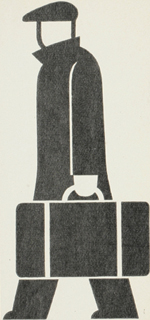Gerd Arntz Archive > The digital collection
Pictorial symbols
The Gerd Arntz archive of the Gemeentemuseum Den Haag consists of 4112 pictorial symbols. Arntz cut his symbols out of a piece of linoleum. The original print block (often approximately 10cm by 5cm) and a number of prints on small pieces of paper are kept in envelopes. All the envelopes are numbered and can be found in sequence in drawers. A print of every symbol has been scanned for The Memory. This is often the best print, usually in black but also frequently in other colors such as green, blue or red.
Some symbols are similar but vary only in size or another small detail. This results in different workers, grains, cows or cars.
Arntz classified the symbols in files. On different pages he arranged symbol groups that belong together. Examples of categories are people (and then broken down into workers, physicians, children, races, etc.), houses, modes of transport and occupations.
Visual statistics
The statistics can to a great extent be found in the Statistical Yearbooks published by the CBS (Statistics Netherlands). For this project, we have chosen not to digitize all the statistics. We have made a representative selection giving a good overview of the use of the pictorial symbols.
Atlas
The atlas ‘Gesellschaft und Wirtschaft’ (Society and Economy) made by Arntz and Neurath, published in 1930 in Leipzig, is a loose-leaf collection of 100 visual statistics. The atlas gives an overview of the most essential empirical data of the world at the time. The atlas is a magnificent example of visual statistics. It shows how easily complicated information can be made more accessible by using pictograms. The atlas was a great success: as a result of this work, Arntz and Neurath were invited to the still infant Soviet Union to set up a similar system and they received orders from various European countries and the United States.

